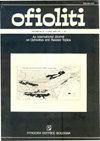Mineralogy, petrology and geochemistry of amphibolites from the Kalnik mt. (Sava Unit, North Croatia): implications for the evolution of north-westernmost part of the Dinaric-Vardar branch of Mesozoic Tethys
IF 1.3
4区 地球科学
Q2 GEOLOGY
引用次数: 9
Abstract
This paper brings a first comprehensive set of mineralogical, petrological and geochemical data of amphibolites associated with mantle peridotites in the Upper Jurassic to mid Lower Cretaceous ophiolite melange of Kalnik Mt. in northern Croatia. This melange is emplaced in a Paleogene sedimentary succession. Metamorphic evolution of the amphibolites and the nature of their igneous protoliths are discussed in the frame of late history development of north-western branch of Dinaric-Vardar Tethys. Primary amphibolite assemblages consist of pargasite-magnesio-hornblende and oligoclase-bytownite (common amphibolite) + almandine-grossular-rich garnet (garnet amphibolites) + clinopyroxene (clinopyroxene amphibolites). Minimum equilibration temperature for the amphibole-plagioclase pairs was estimated at 660±40°C, whereas the peak conditions (790±20°C at 0.79 to 1.04 Gpa) were recorded in garnet amphibolite. Retrograde parageneses (albite, actinolite, clinozoisite, titanite, chlorite, pumpellyite, and ‘metamorphic vermiculite’) correspond to greenschist to sub-greenschist facies conditions. Protolith REE patterns match modern ocean ridge basalts (LaN/LuN = 0.51-0.82) whilst the normalized multi-element diagram shows slight negative HFSE anomalies (NbN/LaN = 0.44-0.90), diagnostic for a subduction-zone geochemical signature. Overall, geochemical data suggest back-arc basin (BAB) tholeiitic mafic extrusives (lack of Eu anomaly) and IAT-like cumulates (Eu positive anomaly) as amphibolite precursors. We propose that the protoliths of the Kalnik Mt. amphibolites represented a metamorphic sole formed at the expense of an oceanic crust originated at the ridge of a back-arc marginal basin. The metamorphism must have taken place during Tithonian (?) as inferred from the protolith age. According to the geological evidences the back-arc magmatic regime was active until the final closure of Mesozoic Tethys in Cretaceous by the obduction of Dinaric ophiolites onto the NW margins of Adria microplate, when part of the metamorphic sole must have been exhumed and obducted together with the rest of ophiolite sequence.克罗埃西亚北部Kalnik山角闪岩的矿物学、岩石学和地球化学:对特提斯中生代Dinaric-Vardar分支最西北端演化的启示
本文首次对克罗地亚北部Kalnik山上侏罗统至中下白垩统与地幔橄榄岩有关的角闪岩进行了全面的矿物学、岩石学和地球化学研究。该混杂岩位于古近系沉积序列中。在特提斯西北支晚期历史发展的框架下,讨论了角闪岩的变质演化及其火成岩原岩的性质。原生角闪石组合由辉长-镁质-角闪石和寡长-长闪石(普通角闪石)+富铝榴辉石(石榴石角闪石)+斜辉石(斜辉石角闪石)组成。角闪石-斜长石对的最低平衡温度为660±40°C,而石榴石角闪石的峰值温度为790±20°C,温度为0.79至1.04 Gpa。逆行共生石(钠长石、放光石、斜沸石、钛矿、绿泥石、泵柱石和“变质蛭石”)对应于绿片岩至亚绿片岩相条件。原岩REE模式与现代洋脊玄武岩相匹配(LaN/LuN = 0.51 ~ 0.82),归一化多元素图显示轻微负的HFSE异常(NbN/LaN = 0.44 ~ 0.90),诊断为俯冲带地球化学特征。总体而言,地球化学数据表明弧后盆地(BAB)拉斑岩基性挤出物(缺乏Eu异常)和iata样堆积物(Eu正异常)是角闪岩的前兆。我们认为,Kalnik山角闪岩的原岩代表了一种变质底岩,这种变质底岩是由起源于弧后边缘盆地脊的洋壳形成的。根据原岩时代推断,变质作用发生在梯东纪(?)。根据地质证据,弧后岩浆活动一直持续到白垩纪中生代特提斯的最终闭合,其主要作用是Dinaric蛇绿岩向亚德里亚微板块的北西边缘逆冲,此时部分变质底岩与其他蛇绿岩序列一起被挖出并逆冲。
本文章由计算机程序翻译,如有差异,请以英文原文为准。
求助全文
约1分钟内获得全文
求助全文
来源期刊

Ofioliti
地学-地质学
CiteScore
2.40
自引率
7.70%
发文量
1
期刊介绍:
Since 1976, Ofioliti provides an international forum for original contributions and reviews in the field of the geodynamics, petrology, geochemistry, biostratigraphy, stratigraphy, tectonics and paleogeography applied to ophiolitic terrains and modern oceanic lithosphere, including their sedimentary cover. Studies of topics such as geodynamics of the mantle, the evolution of orogens including ophiolites and paleoceanography are also welcome
 求助内容:
求助内容: 应助结果提醒方式:
应助结果提醒方式:


